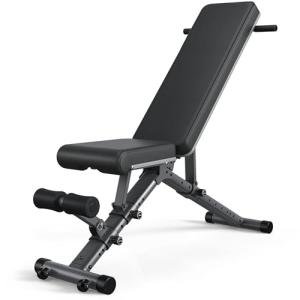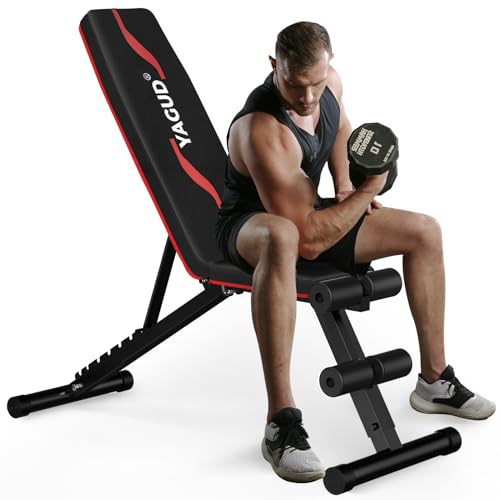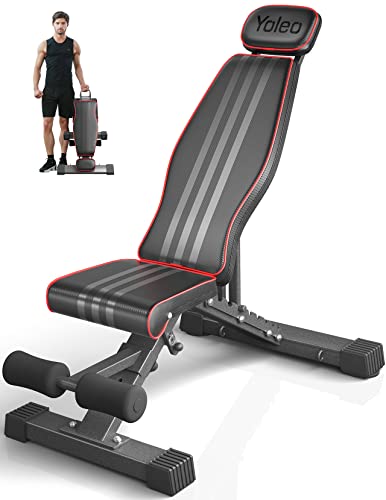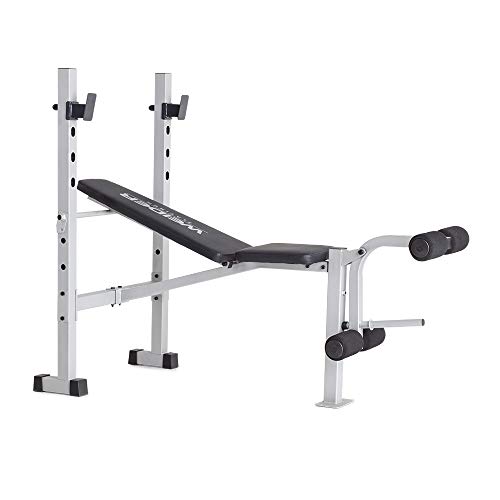Have you ever dreamed of having your own home gym? Imagine the convenience of being able to work out whenever you want without having to leave your house. A home gym can save you time and money while helping you achieve your fitness goals. But where do you start? In this ultimate guide, we'll answer the most common questions about building and maximizing your home gym. From essential equipment to workout routines, we've got you covered. Did you know that having a home gym can not only improve your physical health but also your mental well-being? Studies have shown that regular exercise can reduce stress, anxiety, and depression. Plus, with a home gym, you can avoid the crowds and germs at public gyms. So, let's dive in and explore how you can create the perfect home gym tailored to your needs and preferences.
What equipment is essential for a home gym?
When building a home gym, it's important to invest in essential equipment that will allow you to perform a variety of exercises and target different muscle groups. Here are some must-have items for your home gym:
-
Resistance bands: Resistance bands are versatile and affordable. They can be used for strength training, stretching, and mobility work.
-
Dumbbells: A set of dumbbells is a staple in any home gym. They come in different weights and can be used for a wide range of exercises, from bicep curls to lunges.
-
Kettlebells: Kettlebells are great for full-body workouts and can help improve your strength, endurance, and balance.
-
Yoga mat: A yoga mat provides a comfortable and non-slip surface for floor exercises, stretching, and yoga.
-
Foam roller: A foam roller is a great tool for self-myofascial release and can help reduce muscle soreness and improve flexibility.
-
Pull-up bar: A pull-up bar is a simple but effective piece of equipment that can help you build upper body strength and improve your posture.
| Equipment | Benefits |
|---|---|
| Resistance bands | Versatile, affordable, strength training, stretching |
| Dumbbells | Staple in home gyms, various exercises, different weights |
| Kettlebells | Full-body workouts, improve strength, endurance, and balance |
| Yoga mat | Comfortable, non-slip surface for floor exercises |
| Foam roller | Self-myofascial release, reduce soreness, improve flexibility |
| Pull-up bar | Build upper body strength, improve posture |
Table 1: Essential home gym equipment and their benefits.
By investing in these essential pieces of equipment, you'll be able to create a well-rounded home gym that can help you achieve your fitness goals. Remember, you don't need to buy everything at once. Start with the basics and gradually add more equipment as your fitness level improves and your needs change.
How much space do you need for a home gym?
The amount of space you need for a home gym depends on the type of equipment you plan to use and the exercises you want to perform. However, you don't need a lot of space to create an effective home gym. Here are some tips for maximizing your space:
- Use vertical space: Install shelves or hooks on the walls to store equipment like resistance bands, jump ropes, and yoga mats.
- Choose multi-functional equipment: Opt for equipment that can be used for multiple exercises, such as adjustable dumbbells or a bench that can be used for both strength training and cardio.
- Create a designated workout area: Set aside a specific area in your home for your gym, even if it's just a corner of a room. This will help you stay organized and motivated.
Here's a table that shows the minimum space requirements for different types of home gyms:
| Type of Home Gym | Minimum Space Required |
|---|---|
| Bodyweight | 6' x 6' |
| Resistance bands | 6' x 6' |
| Dumbbells | 8' x 8' |
| Kettlebells | 8' x 8' |
| Multi-functional | 10' x 10' |
Table 2: Minimum space requirements for different types of home gyms.
Keep in mind that these are just minimum requirements. If you have more space available, you can create a more elaborate home gym with additional equipment and workout areas. The key is to make the most of the space you have and create a functional and inviting workout environment.
What are the benefits of having a home gym?
Having a home gym offers numerous benefits, both in terms of convenience and health. Here are some of the top advantages of having your own home gym:
-
Save time: With a home gym, you don't have to spend time driving to and from a public gym. You can work out whenever you want, without having to worry about gym hours or traffic.
-
Save money: While building a home gym requires an initial investment, it can save you money in the long run. You won't have to pay for gym memberships, parking, or gas.
-
Avoid crowds: Public gyms can be crowded, especially during peak hours. With a home gym, you don't have to wait for equipment or deal with other people's sweat and germs.
-
Customize your workout: In a home gym, you can tailor your workout to your specific needs and preferences. You can choose the equipment and exercises that work best for you, without having to compromise.
-
Improve your health: Regular exercise can help improve your physical and mental health. With a home gym, you can make exercise a part of your daily routine, which can lead to better overall health and well-being.
| Benefit | Description |
|---|---|
| Save time | No need to drive to a gym, work out whenever you want |
| Save money | No gym memberships, parking, or gas fees |
| Avoid crowds | No waiting for equipment or dealing with other people's germs |
| Customize workout | Tailor your workout to your specific needs and preferences |
| Improve health | Make exercise a part of your daily routine for better health |
Table 3: Benefits of having a home gym.
In addition to these benefits, having a home gym can also provide a sense of privacy and comfort. You can work out in your own space, without feeling self-conscious or judged by others. Plus, you can create a workout environment that motivates and inspires you, whether that means playing your favorite music or setting up a TV to watch while you exercise.
How to create a budget-friendly home gym?
Creating a home gym doesn't have to be expensive. With a little creativity and some smart shopping, you can build a functional and effective home gym on a budget. Here are some tips:
-
Start with the basics: Focus on essential equipment like resistance bands, dumbbells, and a yoga mat. These items are relatively inexpensive and can be used for a variety of exercises.
-
Shop second-hand: Look for used equipment on online marketplaces, garage sales, or thrift stores. You can often find high-quality equipment at a fraction of the cost of buying new.
-
Get creative with household items: Use items you already have at home, such as filled water bottles for weights, a sturdy chair for step-ups, or a towel for stretching.
-
Invest in multi-functional equipment: Choose equipment that can be used for multiple exercises, such as a stability ball or a set of resistance bands with handles.
-
Look for deals and discounts: Keep an eye out for sales or promotions at sporting goods stores or online retailers. You can also find great deals during holiday sales or end-of-season clearances.
| Budget-Friendly Tips | Description |
|---|---|
| Start with the basics | Focus on essential, inexpensive equipment |
| Shop second-hand | Look for used equipment on online marketplaces or thrift stores |
| Use household items | Get creative with items you already have at home |
| Multi-functional equipment | Invest in equipment that can be used for multiple exercises |
| Look for deals | Keep an eye out for sales, promotions, or holiday discounts |
Table 4: Tips for creating a budget-friendly home gym.
Remember, building a home gym is an investment in your health and well-being. While it may require some upfront costs, it can save you money in the long run and provide countless benefits for your physical and mental health.
What are the best exercises to do in a home gym?
The best exercises to do in a home gym are those that target multiple muscle groups, improve overall strength and endurance, and can be performed with minimal equipment. Here are some examples:
-
Squats: Squats are a compound exercise that target your legs, glutes, and core. They can be performed with bodyweight, dumbbells, or a barbell.
-
Push-ups: Push-ups are a classic bodyweight exercise that target your chest, shoulders, and triceps. They can be modified to suit different fitness levels.
-
Lunges: Lunges are a unilateral exercise that target your legs and glutes. They can be performed with bodyweight, dumbbells, or a barbell.
-
Rows: Rows are a pulling exercise that target your back, biceps, and shoulders. They can be performed with dumbbells, a barbell, or resistance bands.
-
Plank: Planks are a core exercise that target your abs, back, and shoulders. They can be performed on your forearms or hands, and can be modified to suit different fitness levels.
| Exercise | Target Muscle Groups | Equipment Options |
|---|---|---|
| Squats | Legs, glutes, core | Bodyweight, dumbbells, barbell |
| Push-ups | Chest, shoulders, triceps | Bodyweight |
| Lunges | Legs, glutes | Bodyweight, dumbbells, barbell |
| Rows | Back, biceps, shoulders | Dumbbells, barbell, resistance bands |
| Plank | Abs, back, shoulders | Bodyweight |
Table 5: Best exercises to do in a home gym.
In addition to these exercises, you can also incorporate cardiovascular exercises like jumping jacks, burpees, or mountain climbers to get your heart rate up and improve your endurance. The key is to create a well-rounded workout routine that includes both strength training and cardio, and to challenge yourself progressively over time.
How to stay motivated when working out at home?
Staying motivated when working out at home can be challenging, especially if you're used to the social atmosphere of a public gym. Here are some tips to help you stay on track:
-
Set goals: Set specific, measurable, achievable, relevant, and time-bound (SMART) goals for your fitness journey. Write them down and track your progress regularly.
-
Create a schedule: Set aside a specific time each day or week for your workouts, and stick to it. Treat your workouts like any other important appointment.
-
Find an accountability partner: Enlist a friend, family member, or online fitness community to help keep you accountable and motivated.
-
Mix up your routine: Try new exercises, workouts, or equipment to keep things interesting and challenging. This can help prevent boredom and plateaus.
-
Reward yourself: Celebrate your achievements, big and small. Treat yourself to a new workout outfit, a massage, or a healthy meal out when you reach a milestone.
| Motivation Tip | Description |
|---|---|
| Set goals | Set SMART goals and track your progress regularly |
| Create a schedule | Set aside a specific time for workouts and stick to it |
| Find an accountability partner | Enlist a friend or online community to keep you accountable |
| Mix up your routine | Try new exercises or equipment to prevent boredom |
| Reward yourself | Celebrate your achievements with treats or self-care |
Table 6: Tips for staying motivated when working out at home.
Remember, motivation is not a constant state. It's normal to have ups and downs in your fitness journey. The key is to develop a strong sense of discipline and commitment, and to focus on the long-term benefits of regular exercise for your health and well-being.
What are the safety considerations for a home gym?
While working out at home can be convenient and cost-effective, it's important to prioritize safety to prevent injuries and accidents. Here are some key safety considerations for your home gym:
-
Proper form: Learn and practice proper form for each exercise to prevent strain or injury. If you're unsure, consult a certified fitness professional or watch instructional videos from reputable sources.
-
Warm-up and cool-down: Always start your workouts with a proper warm-up to prepare your body for exercise, and end with a cool-down to gradually bring your heart rate down and prevent dizziness or fainting.
-
Wear appropriate clothing and footwear: Wear comfortable, breathable clothing and supportive athletic shoes to prevent slips, trips, or falls.
-
Use equipment properly: Follow the manufacturer's instructions for each piece of equipment, and inspect it regularly for signs of wear or damage. Replace or repair any damaged equipment promptly.
-
Create a safe workout space: Ensure that your workout area is free from clutter, tripping hazards, or sharp edges. Provide adequate ventilation and lighting, and keep a phone nearby in case of emergencies.
| Safety Consideration | Description |
|---|---|
| Proper form | Learn and practice proper form for each exercise |
| Warm-up and cool-down | Start with a warm-up and end with a cool-down |
| Appropriate clothing and footwear | Wear comfortable, supportive clothing and shoes |
| Use equipment properly | Follow manufacturer's instructions and inspect regularly |
| Create a safe workout space | Ensure a clutter-free, well-ventilated, and well-lit area |
Table 7: Safety considerations for a home gym.
In addition to these considerations, it's also important to listen to your body and stop if you feel pain, dizziness, or excessive fatigue. If you have any pre-existing health conditions or injuries, consult with your doctor before starting a new exercise routine. By prioritizing safety, you can enjoy the benefits of a home gym while minimizing the risk of injury or accidents.
How to choose the right flooring for your home gym?
Choosing the right flooring for your home gym is important for safety, comfort, and durability. Here are some factors to consider when selecting flooring:
-
Shock absorption: Look for flooring that provides adequate shock absorption to reduce impact on your joints and prevent injury. Rubber or foam flooring are good options.
-
Traction: Choose flooring with good traction to prevent slips and falls, especially if you plan to do high-intensity or plyometric exercises. Textured or non-slip surfaces are ideal.
-
Durability: Select flooring that can withstand heavy use and equipment without cracking, denting, or wearing down quickly. Rubber, vinyl, or interlocking foam tiles are durable options.
-
Ease of cleaning: Opt for flooring that is easy to clean and maintain, especially if you plan to sweat a lot during your workouts. Smooth surfaces like vinyl or rubber are easier to wipe down than carpet or wood.
-
Noise reduction: If you live in an apartment or shared space, consider flooring that can help reduce noise and vibration from your workouts. Rubber or foam flooring can help absorb sound.
| Flooring Option | Shock Absorption | Traction | Durability | Ease of Cleaning | Noise Reduction |
|---|---|---|---|---|---|
| Rubber | Good | Good | High | Easy | Good |
| Foam | Excellent | Good | Medium | Easy | Excellent |
| Vinyl | Good | Good | High | Easy | Fair |
| Carpet | Fair | Fair | Low | Difficult | Good |
| Wood | Poor | Fair | High | Moderate | Poor |
Table 8: Comparison of different flooring options for a home gym.
Ultimately, the best flooring for your home gym will depend on your specific needs, preferences, and budget. Consider installing a combination of flooring types, such as rubber mats under heavy equipment and foam tiles for general exercise areas, to maximize safety and comfort.
What are the best ways to store home gym equipment?
Storing your home gym equipment properly can help keep your workout area organized, safe, and visually appealing. Here are some storage solutions to consider:
-
Wall-mounted racks: Install wall-mounted racks or shelves to store dumbbells, kettlebells, resistance bands, or other small equipment. This keeps them off the floor and easily accessible.
-
Vertical storage: Use vertical space to store items like yoga mats, foam rollers, or resistance bands. You can use wall-mounted hooks, a coat rack, or a tall shelving unit.
-
Storage benches: Invest in a storage bench that doubles as a seat and a storage container. You can store items like towels, shoes, or extra equipment inside the bench.
-
Pegboards: Install a pegboard on the wall to hang items like resistance bands, jump ropes, or exercise mats. This keeps them visible and easy to grab when needed.
-
Rolling storage carts: Use a rolling storage cart to store items like medicine balls, weight plates, or cleaning supplies. This allows you to easily move them around your gym as needed.
| Storage Solution | Best For |
|---|---|
| Wall-mounted racks | Dumbbells, kettlebells, resistance bands |
| Vertical storage | Yoga mats, foam rollers, resistance bands |
| Storage benches | Towels, shoes, extra equipment |
| Pegboards | Resistance bands, jump ropes, exercise mats |
| Rolling storage carts | Medicine balls, weight plates, cleaning supplies |
Table 9: Best storage solutions for different types of home gym equipment.
When storing your equipment, make sure to keep safety in mind. Secure any wall-mounted racks or hooks properly, and avoid stacking heavy items too high or in precarious positions. Keep your storage area clean and organized, and regularly inspect your equipment for signs of wear or damage.
How to create a well-rounded home gym workout routine?
Creating a well-rounded home gym workout routine is essential for achieving your fitness goals and preventing boredom or plateaus. Here are some tips:
-
Include a variety of exercises: Incorporate a mix of strength training, cardiovascular exercise, and flexibility work into your routine. This helps target different muscle groups and improves overall fitness.
-
Focus on compound movements: Prioritize compound exercises that work multiple muscle groups at once, such as squats, deadlifts, or push-ups. These exercises are efficient and effective for building strength and burning calories.
-
Progressive overload: Gradually increase the intensity, duration, or frequency of your workouts over time to continue challenging your body and seeing results. This can involve adding weight, reps, or sets to your strength training, or increasing the duration or intensity of your cardio.
-
Allow for recovery: Include rest days or active recovery activities like yoga or stretching in your routine to allow your body to recover and prevent overuse injuries.
-
Mix up your routine: Vary your workouts regularly to prevent boredom and keep your body guessing. Try new exercises, workouts, or equipment every few weeks to challenge yourself and maintain motivation.
Here's an example of a well-rounded home gym workout routine:
| Day | Workout |
|---|---|
| Monday | Upper body strength training + HIIT cardio |
| Tuesday | Yoga or stretching |
| Wednesday | Lower body strength training + steady-state cardio |
| Thursday | Rest day |
| Friday | Full-body strength training + HIIT cardio |
| Saturday | Active recovery (hiking, biking, or swimming) |
| Sunday | Rest day |
Table 10: Example of a well-rounded home gym workout routine.
Remember, the best workout routine is one that you enjoy and can stick to consistently. Don't be afraid to experiment and find what works best for you, and always listen to your body and prioritize proper form and safety.
Conclusion
Building a home gym can be a great way to save time, money, and improve your overall health and well-being. By investing in essential equipment, maximizing your space, and creating a customized workout routine, you can achieve your fitness goals from the comfort of your own home.
Remember, starting a home gym doesn't have to be overwhelming or expensive. Begin with the basics and gradually add more equipment as your needs and budget allow. With a little creativity and dedication, you can create a functional and inviting workout space that will help you stay motivated and on track.
So, what are you waiting for? Start building your dream home gym today and take control of your health and fitness!




